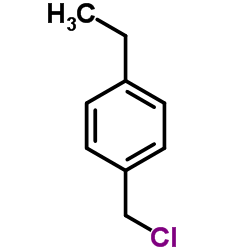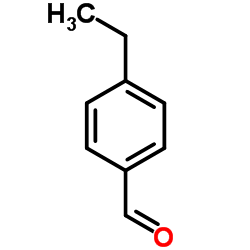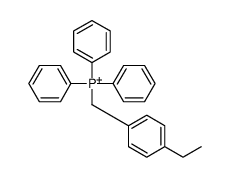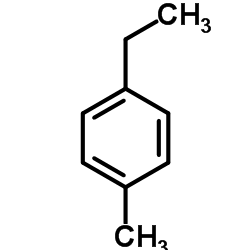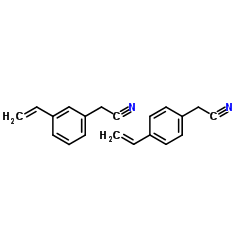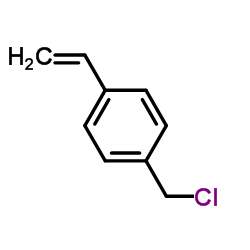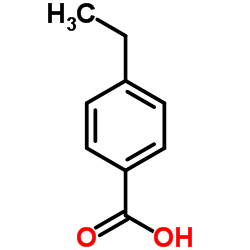1467-05-6
| Name | 4-ethylbenzyl chloride |
|---|---|
| Synonyms |
1-(Chloromethyl)-4-ethylbenzene
1-(Chlormethyl)-4-ethylbenzol MFCD00039357 4-Ethylbenzyl chloride p-ethylbenzylchloride |
| Density | 1.0±0.1 g/cm3 |
|---|---|
| Boiling Point | 217.1±9.0 °C at 760 mmHg |
| Melting Point | -21°C |
| Molecular Formula | C9H11Cl |
| Molecular Weight | 154.637 |
| Flash Point | 83.5±4.3 °C |
| Exact Mass | 154.054932 |
| LogP | 3.48 |
| Vapour Pressure | 0.2±0.4 mmHg at 25°C |
| Index of Refraction | 1.520 |
|
Section I.Chemical Product and Company Identification Chemical Name4-Ethylbenzyl Chloride (contains ca 30% 2-form) Portland OR SynonymBenzene, 1-(chloromethyl)-4-ethyl-(9 CI) Chemical FormulaC2H5C6H4CH2Cl CAS Number1467-05-6
Section II.Composition and Information on Ingredients Toxicology Data Chemical NameCAS Number Percent (%)TLV/PEL 4-Ethylbenzyl Chloride1467-05-6 Min. 65.0(GC) Not available.Not available. (contains ca 30% 2-form) Section III. Hazards Identification Acute Health EffectsCorrosive to skin, eyes, and respiratory system. Liquid or spray mist may produce tissue damage, particularly in mucous membranes of the eyes, mouth and respiratory tract. Skin contact may produce burns. Eye contact can result in corneal damage or blindness. Inhalation of the spray mist may produce severe irritation of respiratory tract, characterized by coughing, choking, or shortness of breath. Corrosive materials may cause serious injury if ingested. Follow safe industrial hygiene practices and always wear proper protective equipment when handling this compound. Chronic Health EffectsCARCINOGENIC EFFECTS : Not available. MUTAGENIC EFFECTS : Not available. TERATOGENIC EFFECTS : Not available. DEVELOPMENTAL TOXICITY: Not available. Repeated or prolonged contact with spray mist may produce chronic eye irritation and severe skin irritation. Repeated or prolonged exposure to spray mist may produce respiratory tract irritation leading to frequent attacks of bronchial infection. Section IV.First Aid Measures Eye ContactCheck for and remove any contact lenses. In case of contact, immediately flush eyes with plenty of water for at least 15 minutes. Get medical attention. Skin ContactIn case of contact, immediately flush skin with plenty of water. Remove contaminated clothing and shoes. Wash clothing before reuse. Thoroughly clean shoes before reuse. Get medical attention. InhalationIf the victim is not breathing, perform mouth-to-mouth resuscitation. Loosen tight clothing such as a collar, tie, belt or waistband. If breathing is difficult, oxygen can be administered. Seek medical attention if respiration problems do not improve. IngestionDO NOT INDUCE VOMITING. Loosen tight clothing such as a collar, tie, belt or waistband. If the victim is not breathing, perform mouth-to-mouth resuscitation. Examine the lips and mouth to ascertain whether the tissues are damaged, a possible indication that the toxic material was ingested; the absence of such signs, however, is not conclusive. Section V.Fire and Explosion Data Auto-IgnitionNot available. FlammabilityMay be combustible at high temperature. Flash PointsFlammable LimitsNot available. Not available. Combustion ProductsThese products are toxic carbon oxides (CO, CO 2), halogenated compounds. WARNING: Highly toxic HCl gas is produced during combustion. Fire Hazards Not available. Explosion HazardsRisks of explosion of the product in presence of mechanical impact: Not available. Risks of explosion of the product in presence of static discharge: Not available. Fire Fighting Media SMALL FIRE: Use DRY chemical powder. LARGE FIRE: Use water spray, fog or foam. DO NOT use water jet. and Instructions Consult with local fire authorities before attempting large scale fire-fighting operations. Continued on Next Page 4-Ethylbenzyl Chloride (contains ca 30% 2-form) Section VI.Accidental Release Measures Spill Cleanup Corrosive liquid. Stop leak if without risk. Absorb with DRY earth, sand or other non-combustible material. DO NOT get water inside Instructions container. DO NOT touch spilled material. Use water spray curtain to divert vapor drift. Prevent entry into sewers, basements or confined areas; dike if needed. Eliminate all sources of ignition. Consult federal, state, and/or local authorities for assistance on disposal. Section VII. Handling and Storage Handling and StorageCORROSIVE. Keep container dry. Keep away from heat. Mechanical exhaust required. When not in use, tightly seal the container and store in a dry, cool place. Avoid excessive heat and light. Do not breathe gas/fumes/ vapor/spray. Never Information add water to this product. Wear suitable protective clothing. If you feel unwell, seek medical attention and show the label when possible. Treat symptomatically and supportively. Always store away from incompatible compounds such as oxidizing agents. Section VIII. Exposure Controls/Personal Protection Engineering ControlsProvide exhaust ventilation or other engineering controls to keep the airborne concentrations of vapors below their respective threshold limit value. Ensure that eyewash station and safety shower is proximal to the work-station location. Personal ProtectionFace shield. Lab coat. Vapor respirator. Boots. Gloves. Suggested protective clothing might not be sufficient; consult a specialist BEFORE handling this product. Exposure LimitsNot available. Section IX. Physical and Chemical Properties Solubility Physical state @ 20°CLiquid. (Clear, colorless.)Not available. 1.05 (water=1) Specific Gravity Molecular Weight154.64Partition CoefficientNot available. Boiling Point Not available.Vapor PressureNot available. Melting PointNot available.Vapor DensityNot available. Refractive IndexNot available.VolatilityNot available. Critical TemperatureNot available.OdorNot available. ViscosityNot available.TasteNot available. Section X.Stability and Reactivity Data Stability This material is stable if stored under proper conditions. (See Section VII for instructions) Conditions of InstabilityAvoid excessive heat and light. Incompatibilities Reactive with oxidizing agents. Section XI. Toxicological Information RTECS NumberNot available. Eye Contact. Ingestion. Inhalation. Skin contact. Routes of Exposure Toxicity DataNot available. Chronic Toxic EffectsCARCINOGENIC EFFECTS : Not available. MUTAGENIC EFFECTS : Not available. TERATOGENIC EFFECTS : Not available. DEVELOPMENTAL TOXICITY: Not available. Repeated or prolonged contact with spray mist may produce chronic eye irritation and severe skin irritation. Repeated or prolonged exposure to spray mist may produce respiratory tract irritation leading to frequent attacks of bronchial infection. Acute Toxic EffectsCorrosive to skin, eyes, and respiratory system. Liquid or spray mist may produce tissue damage, particularly in mucous membranes of the eyes, mouth and respiratory tract. Skin contact may produce burns. Eye contact can result in corneal damage or blindness. Inhalation of the spray mist may produce severe irritation of respiratory tract, characterized by coughing, choking, or shortness of breath. Corrosive materials may cause serious injury if ingested. Follow safe industrial hygiene practices and always wear proper protective equipment when handling this compound. Continued on Next Page 4-Ethylbenzyl Chloride (contains ca 30% 2-form) Section XII.Ecological Information EcotoxicityNot available. Environmental FateNot available. Section XIII. Disposal Considerations Waste DisposalRecycle to process, if possible. Consult your local regional authorities. You may be able to dissolve or mix material with a combustible solvent and burn in a chemical incinerator equipped with an afterburner and scrubber system. Observe all federal, state and local regulations when disposing of the substance. Section XIV. Transport Information DOT ClassificationClass 8: Corrosive material. PIN Number Proper Shipping Name Corrosive liquids, n.o.s. Packing Group (PG)III DOT Pictograms Section XV. Other Regulatory Information and Pictograms TSCA Chemical InventoryThis compound is ON the EPA Toxic Substances Control Act (TSCA) inventory list. (EPA) WHMIS Classification CLASS E: Corrosive liquid. (Canada) EINECS Number (EEC) Not available. EEC Risk StatementsR34- Causes burns. SECTION 16 - ADDITIONAL INFORMATION N/A |
| Hazard Codes | Xi: Irritant; |
|---|---|
| Risk Phrases | R34 |
| Safety Phrases | S26-S36/37/39 |
| RIDADR | 1760 |
| Packaging Group | III |
| Hazard Class | 8 |
| HS Code | 2903999090 |
| Precursor 0 | |
|---|---|
| DownStream 10 | |
| HS Code | 2903999090 |
|---|---|
| Summary | 2903999090 halogenated derivatives of aromatic hydrocarbons VAT:17.0% Tax rebate rate:9.0% Supervision conditions:none MFN tariff:5.5% General tariff:30.0% |
